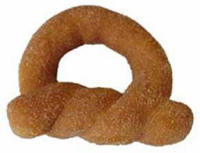This article needs additional citations for verification .(August 2010) |
 | |
| Alternative names | Strik/sjtrik Poeffel |
|---|---|
| Type | Doughnut |
| Place of origin | Netherlands |
| Region or state | Limburg |
| Main ingredients | Flour, yeast, milk, butter, brown sugar, lard |
Nonnevot (also: strik or poeffel) is a Limburgian pastry dating back to the 17th century. Hailing from the town of Sittard, the pastry has traditionally been associated with carnival (Limburgian: Vastelaovend) but is nowadays sold year-round in regional bakeries. Its name: nonnevot, or nun's buttocks, comes from the knotted shape of the pastry, resembling the knot on the back of a nun's tunic. The nonnevot is prepared by deep-frying a mixture of flour, yeast, milk, salt, butter, brown sugar, and lard. [1]